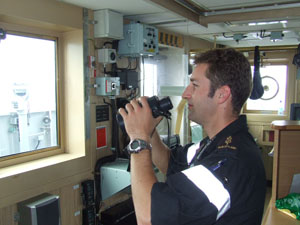Navy Seaman
Tasks & duties

Navy seamen may do some or all of the following:
-
work as part of the ship's crew
-
maintain the ship's husbandry, such as the outside of the ship or the equipment and fittings, by doing a variety of cleaning duties, painting and minor repair work
-
act as a lookout at sea or in harbour
-
transfer stores, personnel and fuel between ships at sea
-
carry out towing operations
-
anchor the ship
-
participate in wartime-scenario training exercises, such as damage-control exercises
-
perform shore-based duties as assigned, such as training new recruits
Navy seamen who are combat specialists may also do some or all of the following:
-
take part in shore patrols
-
board other ships to conduct checks
-
man and operate any weapons 50 calibre or below
-
take part in ongoing weapons training
-
drive the ship under the guidance of a seaman officer
-
drive ships and smaller boats
-
act as a watch person for the seaman officer
-
act as a lookout at sea and in harbour
-
do rope work including knots, whippings, splices and rigging
-
conduct parade training and do ceremonial tasks
Navy seamen who are combat systems specialists may also do some or all of the following:
-
operate the ship's combat systems, radar and sensors
-
detect, track and direct ships, aircraft and submarines in proximity to the ship
-
try to make contact with other ships to classify them as friendly or hostile
-
correlate information received from other ships and aircraft and enter this into a database
Navy seamen who are electronic warfare specialists may also do some or all of the following:
-
operate electronic equipment designed to intercept certain radar transmissions of any ships, submarines or aircraft in proximity to the ship
-
classify these vessels as friendly or hostile
-
enter information into the combat system database
-
operate communication equipment
Specialisations
All navy seamen work as part of the ship's crew, but may also specialise in one of the following areas:
Seaman Combat Specialist
Seamen combat specialists are responsible for weapons operation, boat and ship driving, boarding operations and ceremonial marches.
Combat Systems Specialist
Combat systems specialists are responsible for operating several combat systems designed to track and detect all ships, aircraft and submarines in proximity to the ship for navigational and tactical purposes.
Electronic Warfare Specialist
Electronic warfare specialists are responsible for operating the electronic warfare intercept equipment used to provide early detection of friendly or hostile vessels around the ship.
Skills & knowledge

Navy seamen need to have:
- knowledge of how to operate various weapons, combat systems, sensors and radar
- knowledge of how to use and care for ship equipment
- knowledge of Royal NZ Navy regulations and safety procedures
- good communication skills
- decision-making and problem-solving skills
- computer skills
Seamen combat specialists also need basic knowledge of weapons maintenance.
As navy seamen progress through the ranks they need to develop good leadership skills.
Entry requirements
To enter the Royal NZ Navy you must be at least 17 years old and eligible to be a New Zealand citizen. You need to pass a series of psychometric tests and an interview. You must then pass medical and fitness tests and meet an acceptable standard of eyesight and hearing. You also need to be given security clearance, so any criminal convictions you have will be looked at.
To become a navy seaman you need a minimum of three years of secondary education.
To specialise in electronic warfare you must be at least 19 ½ years old on joining due to specific security clearances required.
Training on the job
On-the-job training begins with a 14-week Basic Common Training Course (BCT) at the Royal NZ Naval College followed by Basic Branch Training (BBT) where you begin training in your specialist area.
If you choose to become a combat systems specialist, you need to complete a 17-week BBT course that teaches the main operating principles behind the equipment you will be responsible for, as well as keyboard skills, retention and memory skills, faster reaction skills and seamanship skills.
If you choose to become a seaman combat specialist, you need to complete a 12-week BBT course that teaches skills in seamanship, weapons operations and maritime military operations. You must pass certain exams during this course.
If you are promoted to leading hand seaman combat specialist, you can undertake an inshore launchmaster course, which is recognised by the Maritime Safety Authority as a civilian qualification for boat operation in New Zealand.
If you choose to become an electronic warfare specialist, you need to complete an 11-week BBT course that teaches you the main operating principles and theories behind the equipment you will be responsible for, as well as security procedures, identification of other vessels and seamanship skills.
You are usually posted to sea within 12 months of completing your Basic Branch Training.
Everyone serving in the ranks has the opportunity to advance to become a navy seaman officer. You need to be recommended by your supervisors and divisional officer, and then be accepted by an Officers Selection Board.
All Royal NZ Navy personnel are given the opportunity to complete relevant part-time tertiary study (fully paid for by the Navy) throughout their career.
Useful experience
A regular fitness programme, involvement in youth organisations or team activities is useful experience.
Related courses
Marine Craft Operation
For more information, please refer to Career Services.
Document Actions
